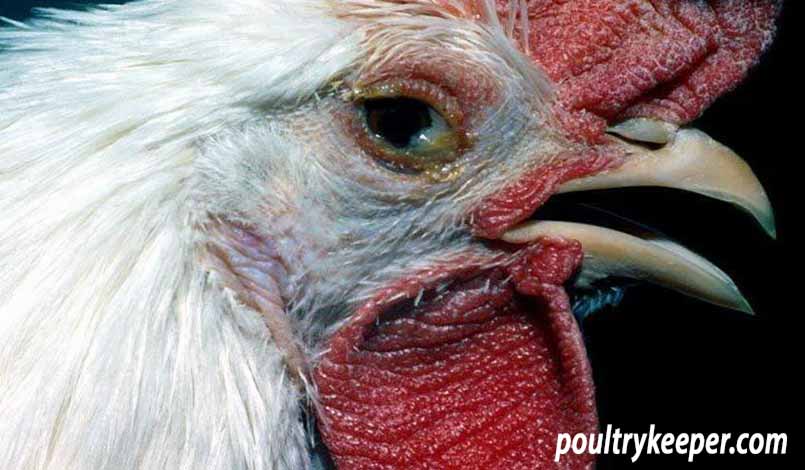Chronic Respiratory Disease:
Synonym: CRD, Mycoplasmosis
- CRD is chronic, slow spreading contagious disease in birds
- It is characterized by obstinate hacking cough, sneezing and tracheal rales.
- Disease is not a great killer but of great economic importance. Affected birds lays less egg than healthy birds.
- Morbidity is typically high but mortality is low in affected flocks.
- Sometimes coli infection complicates disease and this complicated form is now known as CCRD (Complicated Chronic Respiratory Disease).

Etiology:
- Mycoplasma gallisepticum
- Minute, coccoid filtrable organism measuring 0.5µ om diameter.
- This organism donot grow in regular laboratory media. It requires special PPLO media for growth.
- Ideal temperature for growth of mycoplasma is 37-38°C. colony appears as small nipples or dense area followed by thinning at the periphery.
- Organism can be killed by commonly used disinfectants. Formalin can be used for disinfection of the farm.
Epidemiology:
- Disease is distributed globally. Disease occurs in endemic form in most of the poultry farms in India.
- A seroprevalence of 42.5% has been recorded from UP, India.
- In a study conducted at CVL registry, CCRD has fourth highest greatest incidence among poultry disease in Nepal. Out of 2271 cases registered, 196 cases were diagnosed as CCRD, i.e. 9%.
- Disease affects chickens and turkeys naturally.
- Disease usually has high morbidity and low mortality in poultry flocks. In laying birds, it causes decreased egg production.
- Disease is usually complicated by other infectious disease. Most common agent is E. coli followed by IB, Ranikhet disease.
- Stress induces disease more frequently such as cold stress, vaccination with live virus, poor ventilation.
- Disease mostly affects younger birds more severely than adult birds.
- In broiler, most outbreaks occur between 4-8 weeks of age. Disease is more severe during winter.
Transmission:
- Vertical transmission occurs through infected eggs.
- Infection spread through droplet infection or inhalation of organism.
- Nasal discharge is important source of disease transmission.
- Wind also plays important role in transmitting the infection.
- Infection also spread through direct contact with infected birds.
- People are also important carriers of disease. About 60% cross-contamination between poultry farm is due to transportation by people on clothing and equipment.
Pathogenesis:

Clinical Findings:
- Most characteristic symptoms are abnormal respiratory sounds, nasal discharge, sneezing, coughing, and breathing through open beak.
- Decrease in feed consumption
- Decreased in body weight

- In laying flocks, egg production decreases.
- Young birds show conjunctivitis with lacrimation.
- Signs of ataxia and lameness accompanied with enlargement of hock joint may appear in some birds.

PM Findings:
- Exudates are found in nasal passage, trachea, bronchi and airsacs.
- Airsacs usually contains cheese-like inflammatory material.
- Some degree of pneumonia may be seen.
- In severe cases of complication with E. coli, there is pericarditis, perihepatitis and massive air sacculitis.
- Rare cases of tenosynovitis and arthritis may be seen.

Diagnosis:
- Based on the clinical findings and PM findings
- Isolation and identification of microorganism in special media
- ELISA is more sensitive and specific test for detection of antibodies.
- HI test, PCR
Differential Diagnosis:
- Infectious coryza:
- Foul-smelling nasal discharge is present.
- Severe facial edema, disease progress rapidly
- No air sacculitis is observed in infectious coryza.
- Infectious Bronchitis (IB):
- Watery albumen in eggs along with respiratory signs
- No caseous plugs in air sacs
- Kidney lesion are seen in nephrogenic strain.
- ND:
- Greenish diarrhea is seen.
- Nervous signs are also evident along with respiratory signs in ND
- Hemorrhages are found in proventriculus
- Avian influenza:
- Higher mortality as disease progress.
- Cyanosis of comb and wattle
- Hemorrhages in visceral organs
- Colibacillosis:
- It usually complicates CRD
- Air sacculitis is more evident in case of mixed infection.
- Pericarditis and perihepatitis are characteristic findings in case of colibacillosis.
Treatment:
- Mycoplasma is susceptible to several antibiotics. These includes streptomycin, oxytetracycline, kanamycin, neomycin, gentamicin, tylosin, erythromycin, spiramycin, lincomycin.
- Tylosin tartrate is drug of choice for CRD. It is given @ 25–50 mg/kg body weight orally in drinking water for 3–5 days or 3-5 mg/lb b.wt. SC
- Oxytetracycline can be given in drinking water or feed @10-20 mg/kg for 5-7 days.
- Enrofloxacin @10mg/kg, is effective for both mycoplasma and E. coli.
- Supportive therapy such as vitamin A, D, E and C are given to improve immunity.
- Electrolytes are provided in drinking water to reduce stress.
- Liver tonics and probiotics are given to support liver and gut health.
- Egg is treated with tylosin or gentamicin solution before incubation to remove vertical transmission of disease.
Control Measures:
- Treatment donot completely remove the infection in flock, however it reduces mortality, signs and losses.
- Best method to control disease is removal of infection from flock.
- Chicken flocks or breeder stock should be free from M. gallisepticum. They should be screened for infection periodically.
- Ventilation in poultry houses should be removed and ammonia levels should be maintained <25 ppm.
- In case of outbreak, stocking density of fowl should be reduced.
- Litter should be changed periodically. Wet litter should be removed from house and replaced by clean, dry litter.
- Chronically affected birds should be culled and disposed of properly to limit spread.
- Birds should be reared in all in and all out system.
- Movement of people should be restricted within farm.
- Water and feeder used in poultry feeding should be cleaned periodically.
- Vaccination of breeder and layer in endemic areas. Live vaccine are administered to healthy birds at least 3-4 weeks before production starts. F- strain vaccine are used in broiler through eye drop or aerosol at 10 days of age.